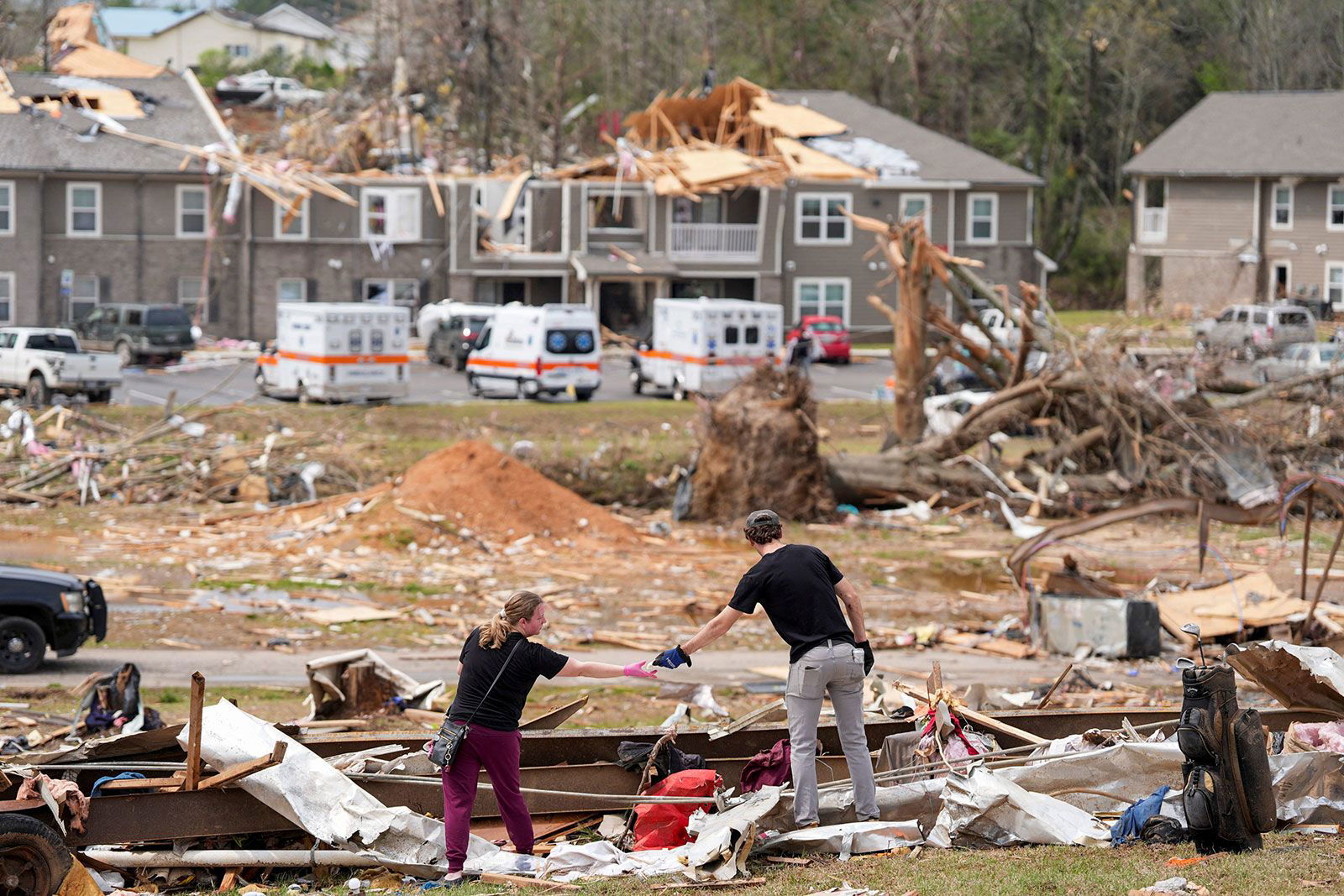The reason for an outburst of deadly storms early in the year could be lurking in the ocean

Jesse Furman is handed one of her belongings by Brayden McLemore near her destroyed trailer in Selmer
By Mary Gilbert, CNN Meteorologist
(CNN) — Back-to-back-to-back deadly and destructive tornado outbreaks in recent weeks have put a punctuation mark on what’s been an unusually active start to the year for thunderstorms in the United States.
The typical peak of severe thunderstorm season is still a few weeks away, so why has it been so busy so early? The answer might be found in what the US government now calls the Gulf of America, still known outside the US as the Gulf of Mexico. It all comes down to geography, particularly the country’s proximity to the Gulf.
The US is the global hotspot for severe thunderstorms and tornadoes because it happens to be where all the necessary atmospheric ingredients for them converge in abundance. The Gulf is a potent source of very moist, warm air that creates the energy that fuels thunderstorms. Powerful storms fire up when that air rushes north and clashes with cold air slicing south from Canada. This happens most often in an area from the Plains to just west of the Appalachians.
Generally, the warmer the air and the more moisture it can hold, the stronger and heavier the resulting thunderstorms become. And the Gulf has been chock full of warmth. It has remained warmer than normal this year after it hit record levels in portions of 2024 and 2023, according to data from the Climate Change Institute at the University of Maine. Both years also had prolific severe thunderstorm action early in the season.
“Warmer oceans mean more evaporation, and we know that the atmosphere is holding on to more moisture,” Shel Winkley, a meteorologist with the non-profit research group Climate Central, explained. “That’s just simple physics we understand with climate change.”
Extra moisture coming from the “bathtub” that is the warm Gulf adds the extra energy boost that fuels stronger storms, according to Winkley.
Plentiful warm, moist air flows north from the Gulf into the US frequently, but severe thunderstorms don’t fire up every single day. They need something to set them off, usually in the form of a potent cold front.
“Once you have that trigger, then climate change is basically loading these days to have the heavier rainfall and potentially even the higher chance for severe weather as well,” Winkley said.
Three tornado outbreaks in as many weeks
More than 100 tornadoes, hail the size of baseballs and hurricane-strength wind gusts unfolded during a wide-reaching outbreak in mid-March that killed at least 42 people. Another outbreak erupted at the end of March that produced at least 50 tornadoes and killed at least 7 people.
A nightmare scenario unfolded as April began. Many of those same people barely had time to recover from what happened to them in March when a massive tornado outbreak struck. It spawned more than 130 tornadoes as storms ripped through the eastern half of the country, killing at least 26 people. At the same time, an entire spring’s worth of rain triggered historic flooding in parts of the Mississippi and Ohio valleys that could take weeks to fully recede.
Further study is needed to say definitively that these specific outbreaks were made worse by climate change, Winkley noted, but past research has shown the atmospheric ingredients needed for events like this are coming together more often in a warming world.
Conditions are now primed for severe thunderstorms about two weeks more often in the spring than they were in 1979 in portions of more than a dozens states from the South to Midwest, according to research from Climate Central.
It’s harder to form a solid trend for climate change’s impact on tornadoes because there is insufficient historical data. Tornadoes are relatively small and short-lived, as far as weather phenomena go, and must be observed and reported. Modern weather radar coverage makes it much easier to spot tornadoes than in the past.
The average number of tornadoes each year in the US hasn’t changed since the 1950s when the weakest tornadoes — EF0s — aren’t included, according to NOAA.
But the tornadoes that do occur are more frequently roaring to life in widespread bunches, rather than in smaller clusters of storms: The frequency of US tornado outbreaks has increased since the 1970s and it is increasing faster for the most extreme outbreaks, a 2016 study found.
Where tornadoes are happening has also started to shift over time.
“We’ve seen more tornadoes shift specifically over portions of the lower Midwest down to the Deep South,” Winkley said. “So, as the climate warms that’s where the severe weather and these tornadoes are really moving to.”
2025’s stats so far
There have been nearly 500 tornado reports since the year began in the US.
Fewer than 300 tornadoes are typically reported through early April, according to data from the Storm Prediction Center.
Both 2024 and 2023 were also quite active into the early spring and the Gulf was also abnormally warm. Activity last year skyrocketed in late April and May. The year ended with the second-most tornadoes on record of the last 15 years, behind only 2017.
March 27 through April 7 marked 12 consecutive days of tornado reports in the US. About 225, or nearly half of the year’s reports were submitted to the SPC in that stretch.
It’s not just tornadoes. More than 3,200 reports of damaging winds have poured into the SPC as of April 10. That’s more than double the amount typically reported in the same timeframe.
May is typically prime time for tornadoes and severe weather, but this April might not be going out quietly. Longer range forecast models are starting to show concerning signals that another widespread bout of dangerous weather could unfold later this month in the central US.
The-CNN-Wire
™ & © 2025 Cable News Network, Inc., a Warner Bros. Discovery Company. All rights reserved.

